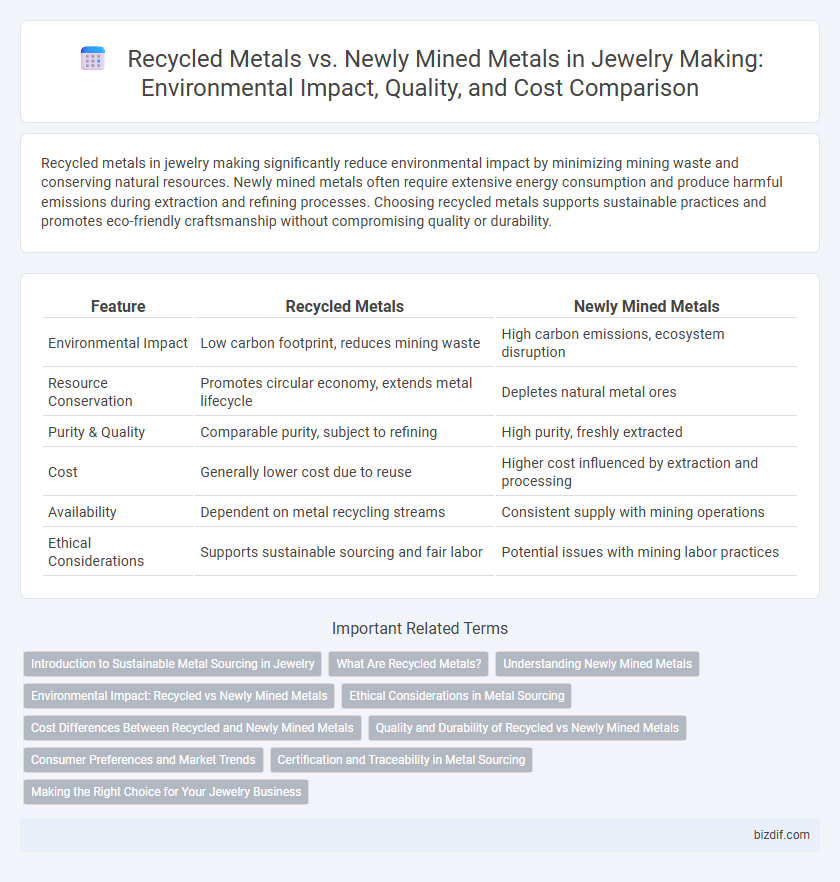Recycled metals in jewelry making significantly reduce environmental impact by minimizing mining waste and conserving natural resources. Newly mined metals often require extensive energy consumption and produce harmful emissions during extraction and refining processes. Choosing recycled metals supports sustainable practices and promotes eco-friendly craftsmanship without compromising quality or durability.
Table of Comparison
| Feature | Recycled Metals | Newly Mined Metals |
|---|---|---|
| Environmental Impact | Low carbon footprint, reduces mining waste | High carbon emissions, ecosystem disruption |
| Resource Conservation | Promotes circular economy, extends metal lifecycle | Depletes natural metal ores |
| Purity & Quality | Comparable purity, subject to refining | High purity, freshly extracted |
| Cost | Generally lower cost due to reuse | Higher cost influenced by extraction and processing |
| Availability | Dependent on metal recycling streams | Consistent supply with mining operations |
| Ethical Considerations | Supports sustainable sourcing and fair labor | Potential issues with mining labor practices |
Introduction to Sustainable Metal Sourcing in Jewelry
Recycled metals in jewelry making significantly reduce environmental impact by minimizing mining activities that deplete natural resources and generate pollution. Using recycled gold, silver, and platinum supports sustainable metal sourcing, lowering carbon footprints and conserving biodiversity compared to newly mined metals. Embracing recycled metals promotes ethical practices while maintaining high-quality standards in fine jewelry craftsmanship.
What Are Recycled Metals?
Recycled metals in jewelry making are materials recovered from previously used metal items, melted down, and repurposed to craft new pieces, significantly reducing environmental impact. These metals retain the same physical and chemical properties as newly mined metals while conserving natural resources and minimizing mining waste. Using recycled metals promotes sustainability by lowering energy consumption and greenhouse gas emissions compared to extraction and processing of virgin ores.
Understanding Newly Mined Metals
Newly mined metals in jewelry making are extracted directly from mineral ores, often requiring extensive energy and water usage, which contributes to environmental degradation. These metals typically provide consistent quality and a wide range of alloy options essential for durable and intricate jewelry designs. Understanding the sourcing and environmental impact of newly mined metals helps jewelers make informed decisions about sustainable practices in their craft.
Environmental Impact: Recycled vs Newly Mined Metals
Recycled metals significantly reduce environmental impact by minimizing the need for mining, which often leads to habitat destruction, soil erosion, and water pollution. Utilizing recycled gold, silver, and platinum in jewelry making decreases carbon emissions and conserves natural resources compared to newly mined metals. This sustainable approach supports circular economy principles, lowering landfill waste and energy consumption throughout the metal refinement process.
Ethical Considerations in Metal Sourcing
Recycled metals significantly reduce the environmental impact of jewelry making by minimizing mining waste and preserving natural ecosystems. Ethical considerations prioritize sourcing metals from suppliers who ensure fair labor practices and transparency in their supply chains. Newly mined metals often pose challenges related to habitat destruction, human rights violations, and excessive carbon emissions, making recycled materials a more sustainable and responsible choice.
Cost Differences Between Recycled and Newly Mined Metals
Recycled metals often have lower production costs compared to newly mined metals due to reduced energy consumption and fewer raw material expenses. Newly mined metals involve extensive extraction, refining, and transportation, driving up their overall costs significantly. Jewelers can benefit from lower prices and sustainability by opting for recycled metals without compromising quality or durability.
Quality and Durability of Recycled vs Newly Mined Metals
Recycled metals in jewelry making retain the same molecular structure as newly mined metals, ensuring comparable quality and durability without compromising strength or malleability. Both recycled and newly mined metals undergo identical refining processes to achieve high purity levels essential for crafting long-lasting pieces. Recycled metals often offer enhanced environmental benefits while matching the performance standards critical for fine jewelry durability.
Consumer Preferences and Market Trends
Consumer preferences in jewelry making increasingly favor recycled metals due to growing environmental awareness and demand for sustainable products. Market trends indicate a significant rise in the use of recycled gold and silver, driven by ethical sourcing concerns and a shift towards circular economy practices. This shift boosts the popularity of brands promoting transparency and eco-friendly materials over traditionally mined metals.
Certification and Traceability in Metal Sourcing
Certification and traceability in metal sourcing are critical for ensuring ethical practices in jewelry making, especially when comparing recycled metals to newly mined metals. Recycled metals often come with verifiable certifications, such as the Responsible Jewelry Council (RJC) or Fairmined, guaranteeing their sustainable origin and reducing environmental impact. Newly mined metals face challenges with traceability due to varying mining standards, making certified supply chains essential to confirm responsible extraction and prevent conflict minerals.
Making the Right Choice for Your Jewelry Business
Choosing recycled metals for jewelry making reduces environmental impact by minimizing mining waste and conserving natural resources, appealing to eco-conscious customers. Newly mined metals may offer more consistent quality and availability but often involve higher carbon footprints and ethical concerns related to mining practices. Prioritizing recycled metals enhances brand sustainability and aligns with growing consumer demand for responsible sourcing in the jewelry industry.
Recycled metals vs Newly mined metals Infographic

 bizdif.com
bizdif.com